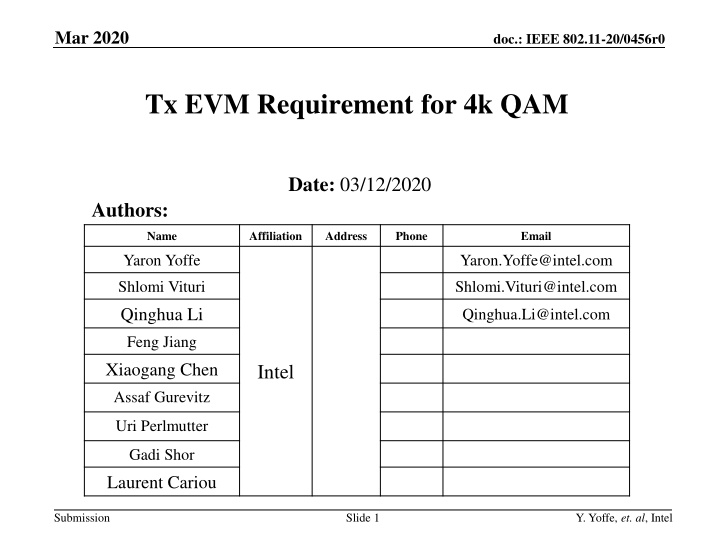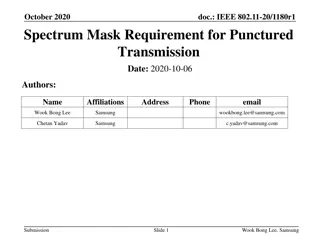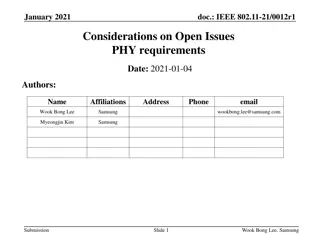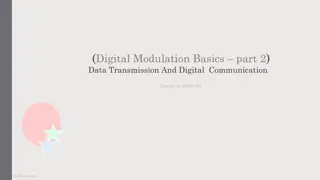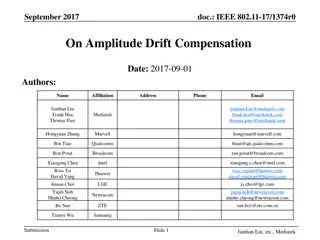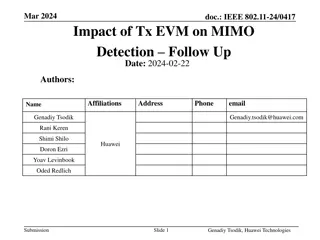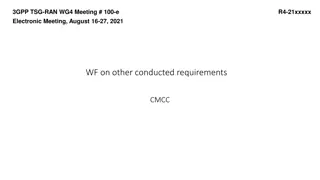IEEE 802.11-20/0456r0: Transmission EVM Requirements for 4k QAM
The document discusses the tradeoff between error vector magnitude (EVM) and transmission power in the context of 4k QAM modulation. It explores the EVM requirements for 4k QAM and addresses issues such as channel estimation errors, modulation and coding scheme (MCS) parameters, and degradation with respect to EVM. Various scenarios and channel estimation methods are presented, highlighting the impact on system performance.
Download Presentation

Please find below an Image/Link to download the presentation.
The content on the website is provided AS IS for your information and personal use only. It may not be sold, licensed, or shared on other websites without obtaining consent from the author.If you encounter any issues during the download, it is possible that the publisher has removed the file from their server.
You are allowed to download the files provided on this website for personal or commercial use, subject to the condition that they are used lawfully. All files are the property of their respective owners.
The content on the website is provided AS IS for your information and personal use only. It may not be sold, licensed, or shared on other websites without obtaining consent from the author.
E N D
Presentation Transcript
Mar 2020 doc.: IEEE 802.11-20/0456r0 Tx EVM Requirement for 4k QAM Date: 03/12/2020 Authors: Name Affiliation Address Phone Email Yaron Yoffe Yaron.Yoffe@intel.com Shlomi Vituri Qinghua Li Shlomi.Vituri@intel.com Qinghua.Li@intel.com Feng Jiang Xiaogang Chen Intel Assaf Gurevitz Uri Perlmutter Gadi Shor Laurent Cariou Submission Slide 1 Y. Yoffe, et. al, Intel
Mar 2020 doc.: IEEE 802.11-20/0456r0 Problem Statement 4k QAM boosts the peak data rate but requires high EVMs However, there is a tradeoff between EVM and transmission power In this contribution, we show the EVM requirements for 4k QAM Submission Y. Yoffe, et. al, Intel
Mar 2020 doc.: IEEE 802.11-20/0456r0 Common Usage Scenario 80 MHz channel, fading Channel D 4x2 SU MIMO with 4 Tx antennas, 2 Rx antennas, 2 streams Beamforming applied AP STA Submission Y. Yoffe, et. al, Intel
Mar 2020 doc.: IEEE 802.11-20/0456r0 Tx EVM It includes channel estimation errors and is 3 dB worse than the actual distortion at the transmitter It is modeled as AWGN, which is the worst case EVM due to phase noise can be mostly cancelled by pilot tracking MCS Parameters Highest MCS with 4k QAM and LDPC 5/6 4k bytes per packet, 20 packets per PPDU Submission Y. Yoffe, et. al, Intel
Mar 2020 doc.: IEEE 802.11-20/0456r0 With ideal channel estimation Curve spacing gets smaller and smaller ? PER -1 10 MCS13 Tx EVM = -inf, Sensitivity = 35.8 [dB] MCS13 Tx EVM = -36 [dBc], Sensitivity = 36.9 [dB] MCS13 Tx EVM = -37 [dBc], Sensitivity = 36.7 [dB] MCS13 Tx EVM = -38 [dBc], Sensitivity = 36.5 [dB] MCS13 Tx EVM = -39 [dBc], Sensitivity = 36.3 [dB] 34 34.5 35 35.5 36 36.5 37 37.5 SNR [dB] Submission Y. Yoffe, et. al, Intel
Mar 2020 doc.: IEEE 802.11-20/0456r0 With LTF based channel estimation Curve spacing gets smaller and smaller PER -1 10 MCS13 Tx EVM = -inf, Sensitivity = 38.8 [dB] MCS13 Tx EVM = -36 [dBc], Sensitivity = 39.9 [dB] MCS13 Tx EVM = -37 [dBc], Sensitivity = 39.6 [dB] MCS13 Tx EVM = -38 [dBc], Sensitivity = 39.4 [dB] MCS13 Tx EVM = -39 [dBc], Sensitivity = 39.3 [dB] 37 37.5 38 38.5 SNR [dB] 39 39.5 40 Submission Y. Yoffe, et. al, Intel
Mar 2020 doc.: IEEE 802.11-20/0456r0 Degradation vs. EVM Degradation is with respect to no EVM case It gets harder and harder to reduce the degradation as the EVM approaches zero. Namely, each dB of EVM drop produces less and less degradation drop e.g. 0.1-0.2 dB per EVM dB drop. Tx EVM (dBc) Degradation with ideal channel (dB) 1.1 0.9 0.7 0.5 Degradation with estimated channel (dB) 1.1 0.8 0.6 0.5 -36 -37 -38 -39 -38 EVM is a good choice balancing Tx power and distortion Submission Y. Yoffe, et. al, Intel
Mar 2020 doc.: IEEE 802.11-20/0456r0 Phase noise effect with ideal channel estimation Phase noise power is calculated from 10k 200 MHz and normalized with respect to the total power of the other distortions PER -1 10 MCS13 Tx EVM = -inf, Sensitivity = 35.8 [dB] MCS13 Tx EVM = -38 [dBc], Sensitivity = 36.5 [dB], PN=100% MCS13 Tx EVM = -38 [dBc], Sensitivity = 36.5 [dB], PN=75% MCS13 Tx EVM = -38 [dBc], Sensitivity = 36.5 [dB], PN=50% MCS13 Tx EVM = -38 [dBc], Sensitivity = 36.4 [dB], PN=25% 34 34.5 35 35.5 36 36.5 37 SNR [dB] Low frequency phase noises are cancelled by removing the common phase rotation Submission Y. Yoffe, et. al, Intel
Mar 2020 doc.: IEEE 802.11-20/0456r0 Conclusion -38 dB Tx EVM is a reasonable choice Degradation is small i.e. about 0.6 dB from the ideal Further EVM reduction may require additional Tx power reduction that shortens the 4k QAM usable range Submission Y. Yoffe, et. al, Intel
Mar 2020 doc.: IEEE 802.11-20/0456r0 Straw Poll Do you support -38 dB as the Tx EVM requirement for 11be 4k QAM? Y: N: A: Submission Y. Yoffe, et. al, Intel
Mar 2020 doc.: IEEE 802.11-20/0456r0 Backup Submission Y. Yoffe, et. al, Intel
